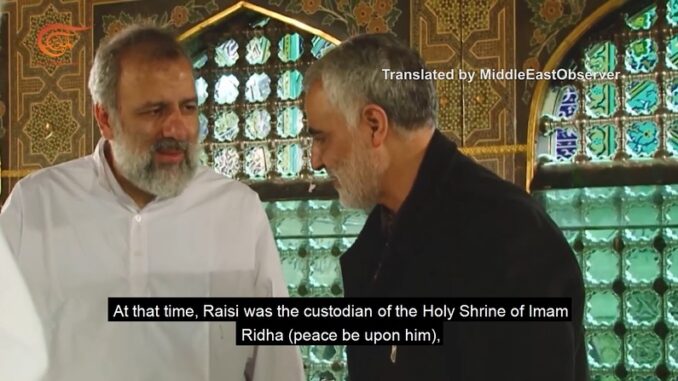
Description:
A short documentary by Al Mayadeen TV on the rise of President Ibrahim Raisi and whether his election will bring a major change to Iran’s strategy in the Middle East and the world. We are translating and publishing this documentary as four parts. This is Part One.
Watch Part Two here
Source: Al Mayadeen Documentaries (YouTube)
Date: August 7, 2021
( Please help us keep producing independent translations for you by contributing a small monthly amount here )
Transcript:
(Part 1 start):
Ibrahim and Ismail, (standing) side by side. Sayyed Ibrahim Raisi, President of the Islamic Republic of Iran, and Ismail Qa’ani, head of the Quds Force of the Islamic Revolutionary Guard Corps, during the funeral ceremony of General Qassem Soleimani.
Perhaps this scene did not have special significance back then, but can it now be said that the election of Raisi will bring a major change to Iran’s strategy in the Middle East and the world? The future will answer this question.
This is one of the last encounters between Ibrahim Raisi and Qassem Soleimani. At that time, Raisi was the custodian of the Holy Shrine of Imam Ridha (peace be upon him), one of the largest Islamic compounds in the world. (Located in) the city of Mashhad, which is within the Razavi Khorasan Province, (Mashhad) annually receives more than 30 million people who visit it for ziyarah (pilgrimage) and tourism.
When Raisi was the custodian of the Holy Shrine of Imam Ridha in 2017, he ran in the presidential elections. In that election, Raisi lost to Hassan Rouhani, but he (still) gained many votes, votes that showed the dissatisfaction of a section of Iranian society with Rouhani’s policies.
This dissatisfaction emerged during the second period of Rouhani’s presidency, who faced a social revolution as a result of the general dissatisfaction of the people towards economic issues.
Four years on, and Raisi re-runs for the presidency.
(The overall participation of) the people frustrated with the (deteriorating social and economic) problems in the presidential election was lower compared to previous (elections). However, Raisi gained more votes than the previous round, which at least indicates the hopes that Iranians have placed in him to solve Iran’s problems.
(Iranian Interior Minister Abdolreza Rahmani Fazli:)
‘The percentage of participation (in the presidential election) was 48.8%. Accordingly, Sayyed Ibrahim Raisi has won first place with 17,926,345 votes, and has been elected by our dear people and has gained their confidence to become the head of the executive branch and President of the Republic’.
With the beginning of the new century of the solar calendar, Raisi was elected as president, at a time when the country was facing numerous economic problems due to the multidimensional economic embargo (imposed) by the US, and the inefficiency of some government agents and officials in setting priorities, which caused a staggering rise in the prices of goods in the country. Moreover, although Iran succeeded in expanding the vaccination (process against Covid-19) to the general public through its own manufactured Covid-19 vaccine, Corona virus is still rapidly spreading (in Iran).
In addition to all these factors, talks between Iran and Western states on the nuclear issue still continue. In the last days of his second term, Rouhani was hoping to reach an understanding and agreement with President Biden, and was hoping for the US to return to the Joint Action Plan agreement. However, the new (US) administration showed stubbornness and intransigence and demanded the reopening of issues that were raised before the nuclear agreement was clinched, such as Iran’s missile program, a request that made the talks more complicated to some extent. Yet, the issue of a Joint Action Plan agreement seems to have bypassed the Iranian government’s policies, and has transformed into a vehicle for targeting the (Iranian) regime.
Considering these circumstances, will there be a significant change in the future of Iran with the start of the new government’s (term) under the leadership of Ibrahim Raisi? And what future awaits Iran with this presidency?
Like Ayatollah Sayyed Ali Khamenei, Sayyed Ibrahim Raisi was born in the Holy city of Mashhad too. He joined the Hawza (Islamic seminary) during his youth.
(President Ibrahim Raisi:)
‘I was 5 years old when my father passed away, he was a clergyman. When he passed away, he had nothing (to leave us) to manage our affairs with. During the first two to three years of my life as a student in the Hawza (Islamic seminary), I had a poor economic situation; I do not remember once buying a kilogram of rice, or half a kilogram of meat. I used to work in the market and spread carpets. I worked in two or three shops, and I used to sell prayer mats, my mother approved of my work there’.
In conjunction with the victory of the Islamic Revolution in Iran, a novel shift occurred in the governing structure of the country. In his twenties, Raisi was elected as representative of the prosecution in the courts of the city of Karaj, located in the suburbs of Tehran. Over the years that followed, he worked as a public prosecutor in western provinces; cities that were close to the war front between Iran and Iraq. Therefore, (Raisi) used to head to the frontlines.
(Part 1 end)
Subscribe to our mailing list!

Leave a Reply